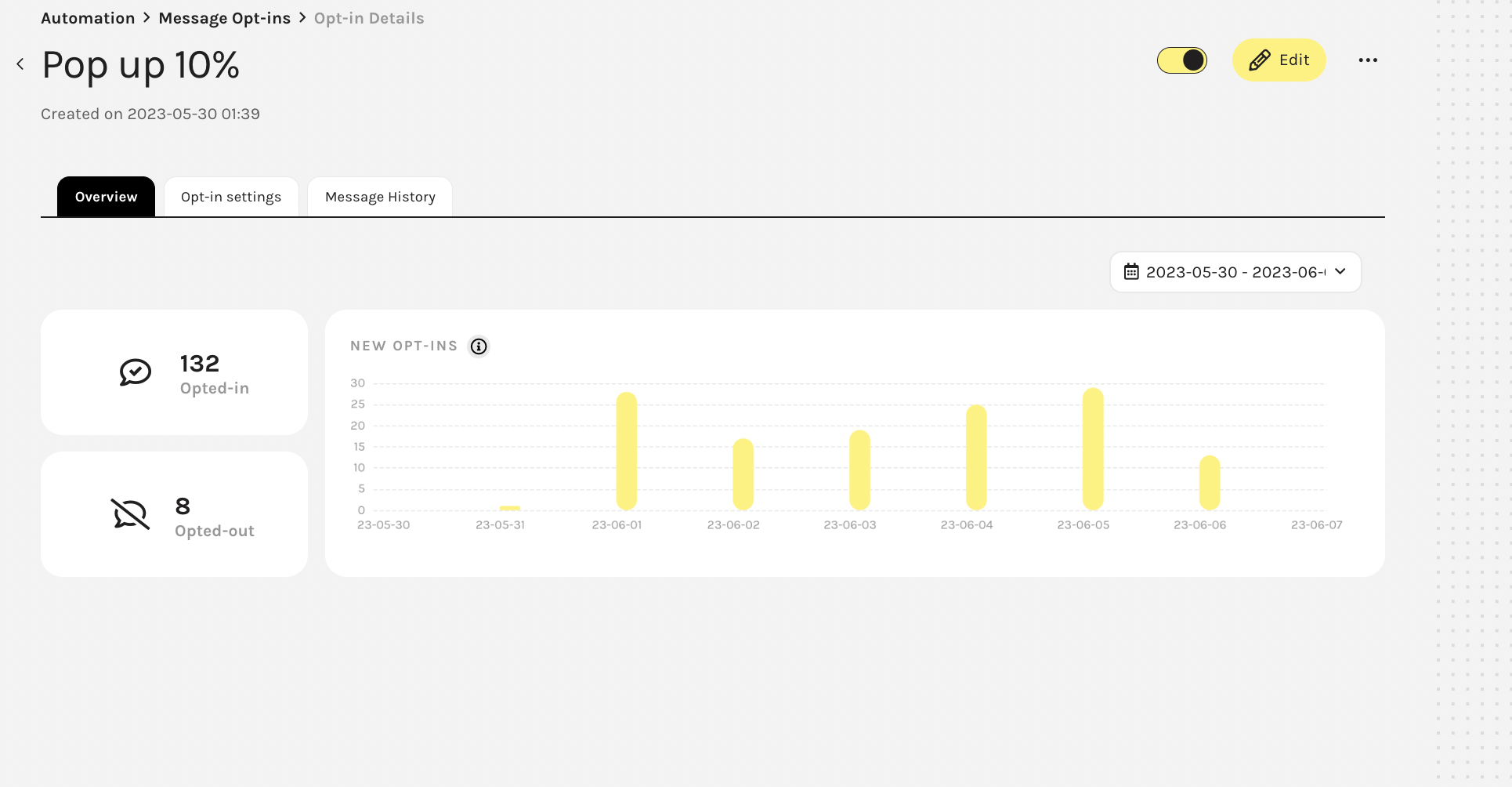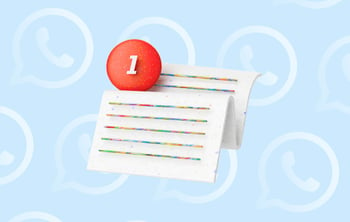By Typie
WhatsApp marketing assistant
Features
,Tips
When you send WhatsApp campaigns to customers, how can you track their success? From return on campaign spend (ROCS) to click-through rate (CTR), these are the 5 main WhatsApp marketing KPIs you need to know...
Is your WhatsApp channel performing well? How can you tell? While marketing key performance indicators (KPIs) for email and social media are well known, WhatsApp marketing KPIs are a little less understood.
But as a marketer, you need to track the success of your WhatsApp campaigns.
In this article, we explain everything you need to know about WhatsApp metrics and analytics for marketing teams:
- WhatsApp KPIs explained
- Why you need WhatsApp chat metrics
- The benefits of WhatsApp KPIs
- The 5 key KPIs of WhatsApp marketing campaigns [with benchmarks]
- 4 other WhatsApp marketing KPIs to watch
- Best practices for tracking WhatsApp KPIs
- To sum up: WhatsApp KPIs are key to your success
WhatsApp KPIs explained
WhatsApp KPIs are ways of measuring the success of a WhatsApp Business channel and your activities within it. Examples are numbers of conversations, conversion rate, revenue generated, ROCS (return on customer spend) and customer lifetime value (CLV).
If you run a WhatsApp channel, you'll need metrics to track the success of service requests, sales efforts and marketing campaigns. In this article, we zoom into WhatsApp KPIs for marketing campaigns.
 The analytics dashboard in the charles WhatsApp platform
The analytics dashboard in the charles WhatsApp platform
Why you need WhatsApp chat metrics
WhatsApp metrics and analytics are important because, as a business, you need to prove the value of a WhatsApp channel – as you would for any other channel. The monetary value to the company needs to be bigger than the outgoing costs.
This is especially important in the current economic climate. With mass layoffs in tech and eCommerce and tightening pursestrings, there's more scrutiny than ever on every team's activities.
And marketing budgets are often the first to get hit.
But if you can prove that your actions are earning a profit, you're more likely to continue operating as you always do.
WhatsApp metrics matter more
In WhatsApp, KPIs and analytics matter even more than other most channels.
Why?
Because you pay per conversation, unlike email which is mostly free to send. A WhatsApp channel has even more pressure on it to earn more revenue than you spend.
Also, although we know the benefits of WhatsApp very well 😉 some people still aren't aware of how amazing it is as a revenue and brand channel. Even though companies in Europe have been using our software for over 2 years now, there's still a perception that it's a new, untested territory.
This is far from the reality, but the more concrete proof you can produce for the doubters, the better.
...unless you're in it for the brand
Profit and WhatsApp metrics are less important if you decide to run your channel as a pure "customer service" or "brand" channel.
In this case, the value to your business could be customer retention or intangible brand benefits.
For example:
- Feedback to improve products: our client, Venezianico, uses WhatsApp to gather customer feedback and suggestions to help them design the next product – which also helps it sell more when it's released (see Venezianico's story)
- Social proof to boost sales: our client, Oatsome, used WhatsApp to gather reviews before a product launch so it could have solid social proof for the public launch (see Oatsome's story)
The benefits of WhatsApp metrics
With good, consistently measured WhatsApp analytics, you can:
- Prove you're continuing to make a profit
- Compare different campaigns and see which ones are successful
- Improve future campaigns based on results
- Show the value of WhatsApp to leadership
- Observe trends in WhatsApp behavior

Opt-in analytics in the charles WhatsApp platform
The 5 key KPIs of WhatsApp marketing campaigns [with benchmarks]
These are the key KPIs you should use to measure the success of WhatsApp marketing campaigns. We've included WhatsApp metric benchmarks based on our own numbers, and a "good" number, so you know if your channel is performing well. All of these are shown in the charles WhatsApp platform analytics:
(Thanks to Daniel Mansky, Client Success Operations Lead for providing these numbers.)
1. Revenue per conversation (RPC)
Benchmark: €2.26
Good: €1.5-2
This is a charles-own term and the main number we look at when assessing the success of a WhatsApp campaign.
It's the average amount spent for every conversation you have through a WhatsApp campaign (total revenue divided by number of conversations).
It will depend on your average order value (AOV) but its trend over time will give you a good idea of how people are responding to your campaign and how profitable your WhatsApp channel is. It's also sometimes called revenue per recipient (RPR).
🧮 How to calculate? Total revenue/no. of people to whom message was delivered
⚖️ Unit: € per conversation
💬 Example: A campaign brings in €1,500, with an audience of 500 = RPC of €3
2. Return on campaign spend (ROCS)
Benchmark: 6-8x
Good: 10x
This is the return on investment of a campaign. It's a "charles-own" term and a very important metric of WhatsApp for our clients – increasingly so as costs come more under the spotlight. (And it's why we called our clients WhatsApp Marketing "ROCStars" at OMR 23.)
🧮 How to calculate? RPC/(WhatsApp cost per conversation + software provider cost per conversation)
⚖️ Unit: x or "times" (like "12x ROCS")
💬 Example: A campaign achieves €2 RPC at a cost of 11c per conversation to WhatsApp and 10 to the software provider = ~10x ROCS
3. Click-through rate (CTR)
Benchmark: 15-20%
Good: 30%
We also sometimes call this "tap-through rate" since WhatsApp is on mobile. It's equivalent to the CTR you're familiar with from email marketing. It measures how many people tapped on a link in your WhatsApp message out of the number that opened it. It's not the number of people who
CTR is a good indicator of how well your campaign engages people. Our clients use this heavily for A/B testing – for example comparing CTR with an image compared to without. How does it compare if you add or don't add a header (tip: adding a header usually performs better).
🧮 How to calculate? (No. people who tapped on message/no. people message was delivered to)*100
⚖️ Unit: %
💬 Example: Campaign is delivered to 200 people, 120 people tapped on it = CTR of 60%
Quick note: why do we say number of people "campaign is delivered to" instead of number of people "you sent a campaign to"? This is because a small percentage of your messages won't successfully reach a phone – for example if the person changed their phone number.
4. Open rate
Benchmark: 85-90%
Good: 95%
Similar to email open rate, how many people opened your inital WhatsApp message out of the number that received it. These tend to be very high in WhatsApp.
🧮 How to calculate? (No. people who opened your message/no. people message was delivered to)*100
⚖️ Unit: %
💬 Example: Campaign is delivered to 200 people, 180 opened it = open rate of 90%
5. Opt-out rate
Benchmark: 0.3-0.6%
Good: 0.2%
This is the same as email unsubscribe rate. It tells you how many people are leaving your WhatsApp channel after you send a WhatsApp campaign. If it's low, it means you're sending relevant, interesting content at the right frequency. If it's high, you should take a closer look at your WhatsApp text, frequency, automated flows and strategy.
🧮 How to calculate? [(Number of people who messaged "STOP" to leave your WhatsApp channel just after you sent a campaign)/(no. of people your message was delivered to)]*100
⚖️ Unit: %
💬 Example: 10,000 people received your campaign and 50 messaged STOP to leave your channel = opt-out rate of 0.5%
4 more WhatsApp metrics
Here are 4 more WhatsApp metrics you can also look at. For more ideas about how to set up your WhatsApp reporting, just ask us:
1. Conversion rate (%)
Many of our clients look closely at conversion rate in WhatsApp. From the number of people that tapped on your campaign, how many bought something? Or how many people who got your message bought something? This is shown in the charles analytics dashboard.
It's not always easy to tell because you can't track everyone's journey (because of Google Analytics relying on cookies and up to 30% of people not accepting cookies). But if you send a unique discount code in WhatsApp, that will help you track this.
You can also analyze conversion rate for opt-in flows – so you can then optimize these. Conversion rate during WhatsApp opt-ins tend to be very good since it's all done in short messages, in one simple conversation.
Also, those who commit to sign up to your WhatsApp channel tend to be very engaged already.
We're seeing figures as high as 50% for opt-in flow conversions.
2. Average order value (AOV) (€/person)
This figure is usually calculated on a long-term basis, not necessarily per campaign. Of course it will depend on the cost of your products and depend on what you’re promoting with your campaign and how much discount you're offering.
We find that companies with a high AOV do particularly well in WhatsApp. This is because they can hugely shorten lead times (like woodboom did, from 4 weeks to 4 days) and offer the personal, instant service that a person spending a large amount of money with a brand usually demands.
3. Total revenue (€)
Not all campaigns are about revenue, but if your goal was to make sales, this number will be important.
It's also a good, simple figure to get a quick idea of how much people are spending with you at each touchpoint, channel and in each campaign.
4. Opt-in rate (%)
Some campaign goals are about how many people opted in to your WhatsApp channel through "Chat-ins". For example through a popup on your website, a QR code in your stores or a "WhatsApp order updates" box on your thank you page after a purchase.
When you're starting out with WhatsApp, this is a useful number. You will need a large number of subscribers to make meaningful numbers in WhatsApp.
Good to know: it's important when opting people in to try and learn something about them (preferences, favorite color, size, location...) so you can send more targeted campaigns later on.
WhatsApp KPIs vs email KPIs
WhatsApp KPIs are quite similar to email, and not too exotic or hard to understand. CTR and open rate for example are common success metrics for both channels.
But in WhatsApp, there's more of a focus on revenue per conversation (RPC). In email, this metric isn't as relevant because you don’t pay per email you send. (See WhatsApp API pricing here.)
In WhatsApp, where you pay a small fee per conversation, the profitability of your channel is very much dependant on the quality of your RPC.
In general (and yes, we would say this), WhatsApp KPIs tend to produce higher numbers than in email. Which is why many of our clients are now putting their WhatsApp channel first in their companywide marketing strategies.
How to measure the success of brand WhatsApp campaigns
Because of the costs attached to WhatsApp conversations, most of our clients are very focused on revenue-generating campaigns.
But it's important to send "brand" campaigns sometimes to strengthen your brand, build relationships with people and keep your brand top of mind. Sending sales-only messages risks your WhatsApp marketing being seen as spam. After all, this WhatsApp is a fun channel where friends and family hang out, you need to tread carefully.
We recommend sending no more than 1-2 campaigns a month, with 1 of them being a brand campaign.
How do you measure the success of brand campaigns? It's harder of course, but you can look at metrics like CTR to measure engagement, numbers of opt-ins you get in WhatsApp.
And you can look at overall increase in revenue in your online shop after you send a branded campaign (not necessarily trackable by UTM links).
How to track the success of WhatsApp campaigns
There are several ways to track the success of your WhatsApp campaigns:
- In your WhatsApp platform: any good WhatsApp marketing software should have good analytics built in. In charles, we show you all of the KPIs we've mentioned and more, and let you export them for easy reading and sharing.
- Google Analytics: you send a campaign linked to a UTM url. Google Analytics is integrated into the charles platform and we automatically generate UTM links.
- Shopify: when you integrate your shop system with charles (as most clients do), your analytics will show up in the charles platform too.
- Other tools: we recommend keeping things simple and not adding too much complexity with yet more tools. However, Tracify is one we recommend, which can produce more precise results than Google Analytics. You can create a special tracking link through Tracify. It's not WhatsApp specific however, and you pay for the software.
Best practices for tracking WhatsApp KPIs
We advise our clients not just to look at Google Analytics numbers. They can differ a lot because of privacy settings (if people don't accept cookies, they won't be tracked).
We recommend you use at least 2 ways of tracking WhatsApp success. These are:
- Google Analytics 4 (UTM links): these are automatically generated in the charles platform when you've integrated Google Analytics with charles.
- Shopify (WhatsApp-only discount codes): when offering discount codes, don't just say "10% off" and link to a web page offering 10% off. Give customers a discount code like SUMMER10 they can only find in WhatsApp. This way you can track their purchases through your Shopify store.
Shopify results will then show up on your charles dashboard beside your Google Analytics results – giving you a better indication of the actual results of your campaign.
You can also easily compare these with a unique email discount code to see which channel is performing better.
What about CLV and CACs in WhatsApp?
Customer lifetime value (CLV) is the amount of money people spend with a company over time. It is of course important, but is more of a long-term metric, and something that deserves an article of its own.
WhatsApp is a long-term channel (which is why we recommend sending regular brand campaigns as well as sales campaigns). Measuring CLV takes time and requires figures over a long period of time. At the moment, many brands are still testing the viability of a WhatsApp channel, so are more focused on short-term metrics to prove its value.
But this doesn't mean CLV isn't important. It is, and WhatsApp is particularly beneficial for CLV. We've found that WhatsApp tends to increase CLV.
For example, SNOCKS researched this and found that customers for whom they have an email address and a WhatsApp number have a higher CLV than those for whom they only have an email address.
Customer acquisition costs (CACs) are also a big concern for eCommerce brands, especially now when money's tight and the future of their business may be uncertain.
However, WhatsApp at the moment is more of a retention channel. You need website visitors and email subscribers who will move into your WhatsApp channel.
In future when there's a WhatsApp directory in Europe and people are more used to using it to connect with businesses, we expect CACs to become more relevant as a metric.
To sum up: WhatsApp KPIs are vital to your success
WhatsApp KPIs are just as important as in any other channel, if not more. There's a perception that they're not yet established, but WhatsApp Business has been around for several years now and there are best practices that have been developed by experienced brands and WhatsApp Business Solution Providers (BSPs) like charles.
WhatsApp and email metrics are similar, but in WhatsApp there's more of a focus on RPC. There are a few key KPIs and many more you can use, depending on your business goals and needs.
You should invest in a good WhatsApp software platform that will give you easy-to-read, easy-to-find analytics you can export for easy sharing.
If you have more questions on WhatsApp KPIs or how to track success, just give us a shout. We love numbers and would be happy to talk them through with you.
FAQs about WhatsApp metrics
What are WhatsApp metrics?
WhatsApp metrics are ways to measure the success of a WhatsApp Business channel. They help businesses understand how well the channel is performing – mostly in terms of profitability, but also in terms of engagement.
The key WhatsApp metrics are return on campaign spend (ROCS, unit: x), revenue per recipient (RPR, unit: €), open rate (unit: %), click-through rate (CTR, unit: %) and opt-out rate (unit: %).
It's best to choose a WhatsApp Business Solution Provider (Meta Partner) that is focused on analytics, and provides simple dashboards you can use to view and export analytics data.
What are the benefits of WhatsApp metrics?
WhatsApp metrics (KPIs) are an essential tool for any CRM or marketing team to:
💰 Prove you're continuing to make a profit
⽐ Compare different campaigns and see which ones are successful
🔮 Improve future campaigns based on results
📈 Show the value of WhatsApp to leadership
💬 Observe trends in WhatsApp behavior
What's the difference between tracking email and WhatsApp campaigns?
Some KPIs that are the same for both email and WhatsApp channels, like CTR and open rate. These figures tend to be much higher in WhatsApp compared to email.
In WhatsApp, you will also need to analyze revenue per recipient (RPR). This is because in WhatsApp, you pay Meta a cost per conversation.
How to you track the success of WhatsApp marketing?
You can do this through the WhatsApp platform you choose. In charles, we show an analytics dashboard.
There are 2 main ways to track WhatsApp KPIs: Google Analytics 4 (GA4) and Shopify discount codes. It's best to integrate both of these with your WhatsApp channel for true results.
Why? Because GA4 analytics can be as much as 30% lower as it relies on cookies, and many people don't accept cookies.
![WhatsApp KPIs: 5 key marketing metrics for tracking success [with benchmarks] blog](jpg/1s_analytics-main%20(1)651e.jpg)




![How to choose WhatsApp marketing software [12 must-haves] | charles](jpg/01%20preview4411.jpg)

2443.jpg)